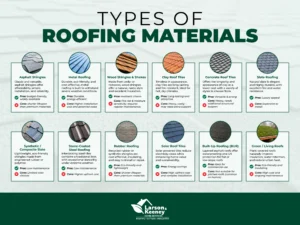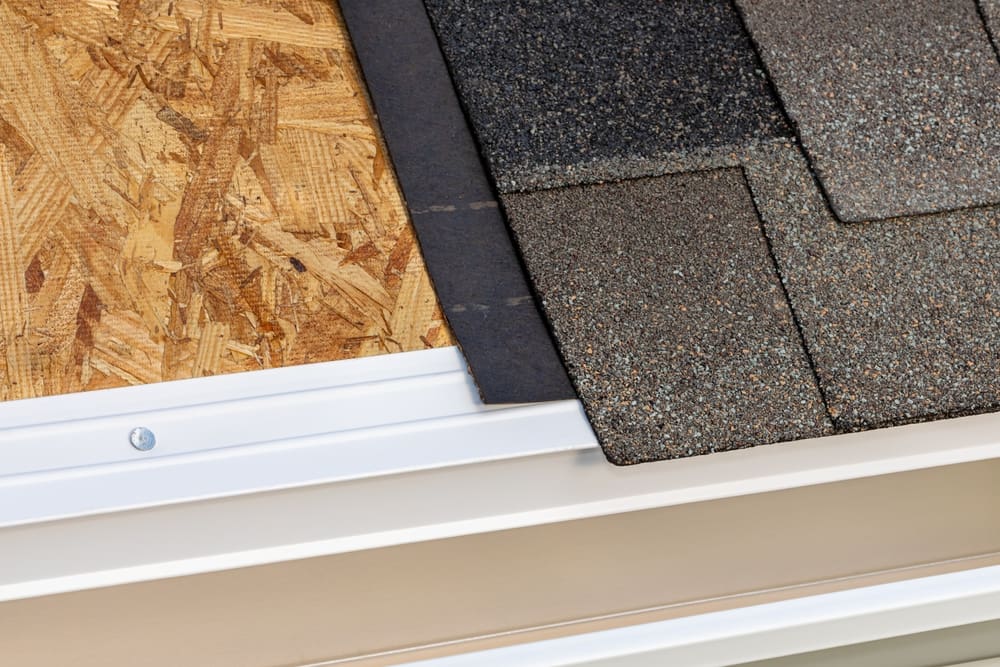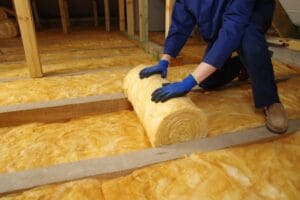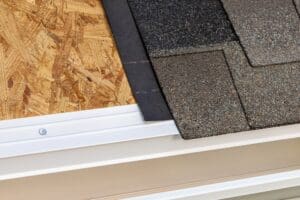Your roof not only protects your family and belongings but also plays a key role in energy efficiency and home value. With numerous types of roofing materials on the market, how do you know which one to choose?
In this guide, we’ll walk you through the different types of roofing materials available and how to select the right one based on appearance, lifespan, and cost considerations.
Asphalt Shingles
Asphalt shingles are the most common roofing material for homes in Wisconsin. They are versatile, affordable, and relatively easy to install. There are two primary types of asphalt shingles: 3-tab shingles and architectural shingles.
- Lifespan: Typically lasts between 20–30 years
- Pros:
- Affordable and widely available
- Easy to install
- Available in a variety of colors and styles
- Cons:
- Shorter lifespan compared to premium materials like slate or metal
- Susceptible to wear in extreme weather conditions
For homeowners seeking a reliable roof within a modest budget, asphalt shingles are often the go-to choice.
Metal Roofing
Metal roofing is a durable and eco-friendly option favored for its longevity. Metal can last between 50 to 70 years, making it one of the most cost-effective roofing choices. It’s especially suitable for homes in areas prone to severe weather conditions.
- Lifespan: 50–70 years
- Pros:
- Excellent durability and longevity
- Fire-resistant
- Snow-shedding capabilities
- Energy-efficient, reflecting heat to reduce cooling costs
- Cons:
- Installation can be more complex
- Noise from rain or hail may be a concern
Given its energy efficiency and durability, metal roofing is a solid choice for homeowners who prioritize long-term performance.

Types of Roofing Materials PDF
Wood Shingles and Shakes
Wood shingles and shakes are ideal for homeowners looking to add a natural, rustic charm to their home. Commonly made from cedar or redwood, these types of roofing materials have a distinct appearance and can last up to 60 years with proper maintenance.
- Lifespan: 20–60 years
- Pros:
- Luxurious, natural appearance
- Great insulation properties
- Cons:
- Vulnerable to fire and moisture
- Requires regular maintenance
Wood shingles and shakes offer added curb appeal, but they require extra care to maintain their appearance.
Clay Roof Tiles
Clay tiles are a classic roofing choice known for their timeless appeal and exceptional durability. They are commonly seen in Mediterranean, Spanish, and Southwestern-style homes, particularly in warmer climates.
- Lifespan: 50–100 years
- Pros:
- Extremely durable and long-lasting
- Fire-resistant
- Attractive, with a traditional aesthetic
- Cons:
- Heavy, requiring extra structural support
- Not ideal for areas with heavy rainfall or freezing temperatures
Clay tiles are best suited for homes in dry, warm climates where their weight and durability offer long-term value. If you’re considering this material, make sure your regional weather patterns can support it.
Concrete Roof Tiles
Concrete roof tiles are similar to clay tiles in terms of durability and appearance, but they are slightly more affordable. They are commonly selected for their ability to withstand harsh weather conditions.
- Lifespan: 50+ years
- Pros:
- Durable and long-lasting
- Fire-resistant
- Available in various styles and colors
- Lower cost than clay tiles
- Cons:
- Heavy, requiring additional structural support
- More expensive to install than asphalt shingles
Concrete roof tiles provide excellent protection for homes in regions with extreme weather conditions.
Slate Roofing
Slate roofing is a premium roofing material that offers unmatched longevity and a classic aesthetic. Known for its natural beauty, slate can last over a century with proper care.
- Lifespan: 75–150 years
- Pros:
- Extremely durable and long-lasting
- Fire-resistant
- Waterproof
- Elegant and high-end appearance
- Cons:
- Expensive to install
- Requires expert installation
- Heavy, requiring structural support
If you’re seeking a luxury, long-term solution for your roof, slate is a standout material. Its timeless appeal and superior durability make it a long-lasting investment.
Synthetic/Composite Slate
Synthetic or composite slate roofing mimics the appearance of natural slate but is made from engineered materials like rubber or polymer. It offers many of the benefits of slate, with the added advantage of being lighter and more affordable.
- Lifespan: 40–50 years
- Pros:
- Lightweight and easier to install
- Eco-friendly (recycled materials)
- Mimics the appearance of natural slate
- Cons:
- Limited color options
- Can be less durable than natural slate
Synthetic slate is a great alternative for homeowners who want the look of slate without the heavy cost and roof installation challenges.
Stone-Coated Steel Roofing
Stone-coated steel roofing is a versatile option that combines the strength of metal with the aesthetic appeal of traditional roofing materials like slate or clay. These interlocking tiles are designed to withstand extreme weather and provide long-lasting protection.
- Lifespan: 40–60 years
- Pros:
- Highly durable and weather-resistant
- Low maintenance
- Offers a variety of styles to mimic other materials like clay or slate
- Cons:
- Installation is more complex
- Can be more expensive than asphalt shingles
Stone-coated steel offers the look of a traditional roof with the durability and performance of metal.
Rubber Roofing
Rubber roofing is often made from recycled rubber or synthetic materials. It’s sustainable and offers a cost-effective and easy-to-install alternative to traditional types of roofing materials.
- Lifespan: 15–30 years.
- Pros:
- Low cost and easy installation
- Excellent insulation properties
- Durable and resistant to cracking
- Eco-friendly (made from recycled materials)
- Cons:
- Not as aesthetically pleasing as other roofing materials
- Can be prone to UV degradation over time if not properly maintained
Rubber roofing provides increased value for homeowners looking for affordable and sustainable roofing options.
Solar Roof Tiles
Solar roof tiles use photovoltaic technology, allowing homeowners to generate their own electricity. This cutting-edge roofing material is sustainable and enhances curb appeal and home value.
- Lifespan: Varies
- Pros:
- Generates clean, renewable energy
- Can help lower energy bills
- Ideal for eco-conscious homeowners
- Can increase home value
- Cons:
- Higher upfront cost
- May be subject to HOA restrictions
- Installation requires expertise
Solar roof tiles offer an innovative solution to enhance energy efficiency without compromising the style of your home.
Built-Up Roofing (BUR)
Built-up roofing, or BUR, is a traditional roofing material commonly used for flat or low-slope roofs. It is constructed with several layers of asphalt, tar, and adhesive that provide added protection against UV rays, water, and weather.
- Lifespan: 15–30 years
- Pros:
- Waterproof and fire-resistant
- Ideal for flat and low-slope roofs
- Low maintenance
- Cons:
- Can be heavy, requiring structural support
- Not suitable for pitched roofs (common on homes)
BUR is one of the most popular types of roofing materials for commercial buildings. It doesn’t suit pitched roofs, which are common on residential homes.
Green/Living Roofs
Green, or living, roofs are increasingly popular among homeowners in urban areas. They’re covered with vegetation that provides many environmental benefits, including natural insulation, water retention, and reduced urban heat.
- Lifespan: Varies based on maintenance and climate
- Pros:
- Reduces heat in urban areas
- Improves energy efficiency
- Can help manage stormwater runoff
- Provides natural beauty and biodiversity
- Cons:
- Requires significant structural support
- Regular maintenance needed
- Higher initial installation costs
Living roofs are a unique and environmentally friendly roofing material that can provide long-term benefits in urban environments.
How To Choose the Best Roofing Material for Your Home
Different types of roofing materials perform better in different environments and complement various home designs. Picking the right one is key to long-term protection.
When selecting the best roofing material for your home, consider your budget, climate, roof pitch, and personal style.
For the best results, consult a licensed roofing contractor who can assess your home’s unique needs. Larson & Keeney Home Services offers free inspections and expert advice to help you find the perfect roofing material for your budget, style, and needs.
Choose Larson & Keeney Home Services for Reliable Roofing Across Wisconsin
When it comes to protecting your home, trust the local experts at Larson & Keeney Home Services. Our certified team brings over 15 years of experience to provide durable, high-quality roofs across Wisconsin. Whether you need a roof replacement, installation, or repair, we’re dedicated to keeping your home safe, secure, and energy-efficient with exterior solutions built to last. Contact us today to schedule your free inspection.




